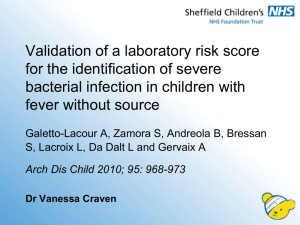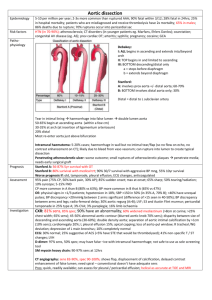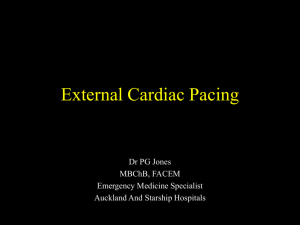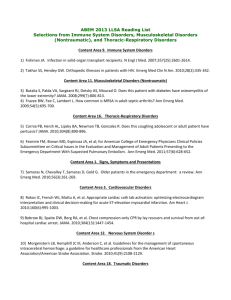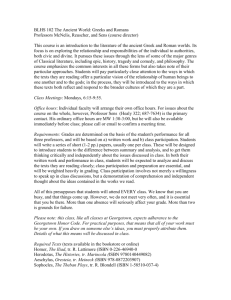Diagnostic Imaging Issue in the ED
advertisement
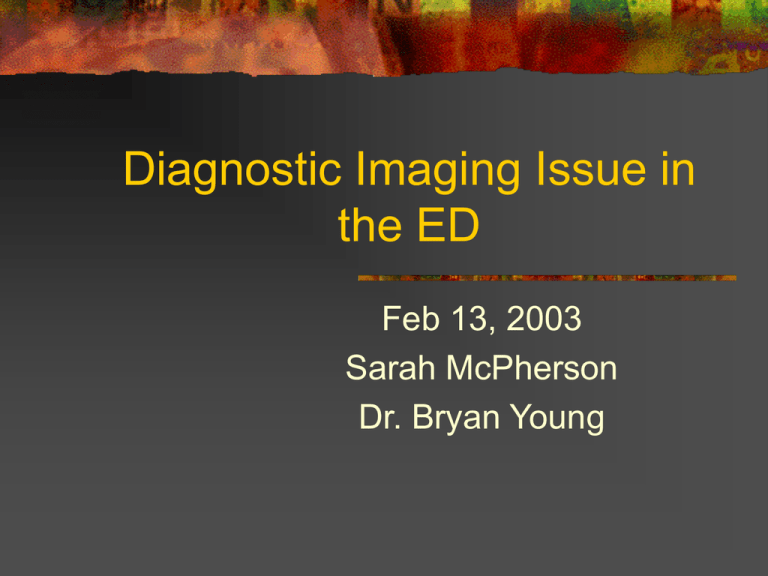
Diagnostic Imaging Issue in the ED Feb 13, 2003 Sarah McPherson Dr. Bryan Young Outline U/S vs CT U/S in the ED AAA, blunt abdo trauma, 1st trimester bleed, gall bladder disease U/S by ED docs CT for appendicitis CT vs IVP for renal colic Imaging for carotid dissection Imaging scaphoid injuries MSK infections in pediatrics U/S vs CT U/S PROS Noninvasive No radiation Portable Records motion (vascular pulsation”) CONS Poor visualization 2nd to body habitus and gas patterns Required positioning may be difficult Does not visualize retroperitoneum CT PROS Visualizes retroperitoneum Quick Not limited by body habitus or abdominal distension High accuracy CONS Radiation exposure Patient must leave the ED Ultrasonography A 50 yo woman presents with RUQ pain X 4hr after eating her kid’s Happy Meal at McDonald’s. You’re wondering if you order an Ultrasound how good is it at telling you that this patient has acute cholecystitis?? Imaging the Gallbladder 90-95% of acute cholecystitis will have stones U/S is 95% sensitive to see stones Stones + wall thickening or a + Murphy’s sign has a PPV of 95 and 92% for acute cholecystitis Sensitivity for acalculous chole is 67-92% EMR vol 17/15, July 22, 1996 Imaging the Aorta A 70 year old hypertensive man presents with acute flank pain. He also has a history of kidney stones 30 years ago And is unsure if this pain is the same. He is writhing around in the bed. You think he may have renal colic but a leaking AAA is also on the differential. You wonder…how good is ultrasound at visualizing the aorta???? Imaging the Aorta with U/S An U/S is very good at telling you if there is an aneurysm (dilation >3mm) It has a sensitivity of 97% It is NOT sensitive enough at detecting an intimal flap to rule out a dissection and it cannot tell you if there is a current leak…for that you need to go on to CT EMR vol 17/15, July 22, 1996 Blunt Abdominal Trauma We’ve covered this before but a review is never bad…. DPL vs U/S vs CT DPL: Positive = aspiration of > 10cc frank blood, RBC > 100,000/ mm3, WBC > 500/mm3, + gram stain Pros: patient doesn’t leave department, fast and easy, cheep, sens = 94-96%, spec = 96-99% Cons: invasive, technically difficult in obese and preg pt, misses diaphragmatic and retroparitoneal injuries Blunt Abdo Trauma Ultrasound Pros: fast, portable, noninvaasive, sens = 80100%, spec = 94-100% Cons: relies on experience of technician, sensitivity for specific organ injury and retroperitioneal injury low, obesity, sc emphysema, and open wounds will decrease visualization Blunt abdo trauma Blunt abdo trauma CT Pros: very accurate (97% in detecting injury), fast, visualizes solid organs and retroparitoneum Cons: patient must be transported to scanner, exposure to radiation and iv contrast U/S in 1st trimester bleeds A 23 yr woman G2P1 presents with vaginal bleeding. She thinks she is about 6 weeks by dates. What do you expect to see on ultrasound and how do you interpret the U/S with serum BhcG levels? U/S in the 1st trimester Of patients with vag bleed or pelvic cramping or both ~ 60% will have pregnancies that develop normally, 10% will be ectopics,and 30% will end in a miscarriage U/S findings and serum BhcG Transvaginal U/S Gestational sac seen at 5 wks with BhcG of 1000-1,800 Yolk sac seen at 6 wks with BhcG of 2,500 Fetal pole seen at 7 wks with BhcG of 5,000 Fetal heart rate at serum BhcG of 17,000 (fetal pole at ~ 5mm in length) Ann Emerg Med. 1999.33/3 How to interpret if there is a fetal heart beat It is a live intrauterine gestation ~ 1/30,000 pregancies (without fertility meds) will have an intra and extra uterine pregnancy 2-4% with a fetal heart beat have spontaneous abortion If there is a subchorionic hemorrhage…the spontaneous abortion rate is 30% Emerg Med Clin. 1997. 15/4:789-823 How do you know if it is an abnormal pregnancy??? When there is no fetal pole and the gestational sac is > 16mm on EVS or > 25mm on TAS this is likely early fetal demise A gestational sac > 10mm should have a yolk sac (but some will still be a normal IUP) A fetal pole > 5mm should have a fetal heart beat (the absence is the most reliable finding of a nonviable IUP) Ann Emerg Med. 1999: 33/3 In symptomatic patients with echogenic material and no gest sac, likelihood of IUP is low Acad Emerg Med. 1999; 6/2: 116-20 How do you know if it is an ectopic???? ~ 39% of ectopics with BhcG < 1,000 can be identified on U/S Ann Emerg Med. 1999; 33/3 Definitive for ectopic: echogenic ringlike structure outside the uterus with a gest sac with a yolk sac or fetal pole R/o’d if there is evidence of a definite IUP (gest sac with yolk sac or fetal pole) or probably r/o’d if there is evidence of an abnormal IUP (gest sac >10mm with no yolk sac or > 16 mm & no fetal pole) Other signs of an ectopic Abnormal adnexal mass (solid or cystic separate from ovary) 70% will be an ectopic Large anechogenic or echgogenic fluid in the cul-de-sac 50-80% will be an ectopic Ann Emerg Med. 1999;33/3 Severe adnexal tenderness with probe pressure Emerg Med Clin.1997;15/4:789-823 Endometrial stripe Acad Emerg Med.1999;6/6:602-8 What about ER docs doing U/S?? What are the reasons??? To improve quality care Decrease time to emergency scans Lessen the need to send potentially unstable patients out of the ED Improve patient flow Increased staff satisfaction Improve patient satisfaction Decrease stress on ancillary departments Ann Emerg Med. 1997;29/3:367-74 What is different about us doing U/S?? obviously we have less training It is highly focused (usually just looking to answer 1 question ie Is there an AAA?) It is interactive (extension of physical exam) It is brief May be repeated as clinically warranted Emphasizes 1 finding, it is NOT comprehensive (formal techs should do this) Emerg Med Clin. 1997;15/4:735-43 What is the scope of ED U/S Emergent Scans: Urgent Scans: AAA Cardiac arrest/tamponade ? Live IUP (1st trimester symptoms & maternal trauma) Abdo trauma ? Gallstones ? Obstructive uropathy To facilitate procedures Lines, thoracentesis, paracentesis, pericardiocentesis, FB removal, suprapubic aspiration Ann Emerg Med. 1997;29/3:367-74 How good are we??? ED MD’s doing U/S in blunt abdo trauma J of Trauma.1995;38/6:879-85 Prospective, N = 245, U/S vs CT/DPL or lap Sens = 90% Spec = 99% Accuracy = 99% Ingerman et al.Acad Emerg Med.1996 N = 97, U/S vs DPL/CT or lap Sens = 75% Spec = 96% Accuracy = 91% There were no FP/FN after 67 scans At detecting AAA…??? There’s more evidence but alas I didn’t have time to find it all…. Acad Emerg Med. 1994;12/2;185-9 N = 11 Sens and spec = 100% Ann Emerg Med. 2000;36/3:219-23 N = 68, prospective, gold standard = Sx, other imaging, radiologist review of ED U/S Sens = 100%, spec = 100% At identifying IUP? Ann Emerg Med.1997;29/3:348-351 N = 115, EPPS vs rads or obs/gyn Sens = 94%, spec = 100% for IUP No adverse outcomes EPPS had decreased LOS Ann Emerg Med. 1997;29/3: 338-47 N = 136, if definite IUP d/c with follow up until definitive dx confirmed, equivicable cases referred to rad/obs/gyn Sens = 90%, spec = 88% for making dx of Ectopic Pregnancy Does doing transvaginal U/S in the ED decrease patient wait times?…it appears so! Acad Emerg Med.1998;5:802-17 N = 84 (46 in ED), retrospective Time to discharge ED U/S vs Obs/gyn U/S 164(+/- 13) min vs 235 (+/- 12) min No EP were missed by ED U/S Acad Emerg Med. 2000;7:988-93 N = 1419 (277 in ED), retrospective Of confirmed IUP cases, time in ED was 59 min (4977min) less in ED MD group than rad group; time was longer (77min CI 55-97) from 6pm-6am How about detecting pericardial fluid?? Ann Emerg Med. 2001;38/4:377-82 N = 515 (103 who had effusion) Prospective, ED MD (5 hrs training in Echo) Echo then reviewed by cardiolgy, ? Adequate study and ? Was there fluid Sens = 96%, spec = 98% 93% of the 515 studies were found to be technically adequate On to CT…. A 40 yo female presents to the ED with RLQ pain. She had diffuse pain initially and is now localized for the past hour. She is nauseated and is not anorexic. On physical exam she has percussion tenderness in the RLQ, a + Rovsig’s sign and appears uncomfortable with movement. Her urine BhcG is negative. Do you call surgery right away, do a CT scan, send her home with some T3’s…??? CT’s for appy’s Clinically the rate of normal appy’s with Sx is 22-30% Am J surg. 1981;141:232-4, J R Coll Surg Edin.1983;28:35-40, BMJ. 1972;2:9-13 Can this be improved with better imaging??? CT’s for appys MANY studies have been done Clin Rad. 2002;57:741-45 N = 50, prospective Pre-op CT’s ? Signs of appendicitis Compared with surgical and histological findings Sens = 95%, Spec = 92%, an alternate diagnosis was found in 10 of 12 CT’s that did not have evidence of Appendicitis More evidence on CT for appys AJR.2002;178:1319-25 N = 650, retrospective, surgical and clinical records used for follow-up (85% had adequate follow-up) Sens = 97%, Spec = 98% In patients without appendicitis CT revealed an alternate diagnosis in 62% of cases Still more evidence Radiology. 2001;221:747-53 N = 100, prospective all clinically equivocal (no RLQ peritonism, no fever, no vomiting, no leukocytosis, observed for > 24 hr in hospital) 30 pos CT, 70 neg CT (2 FP, 2 FN) Sens = 93%, Spec = 97% Now some evidence against imaging Arch Surg.2002;136:556-62 N = 766, retrospective (only patients who had appendectomies) Compared clinical features, pre-op CT & pre-op U/S with surgical findings Findings: migratory pain PPV 91%, WBC > 12 PPV 90%, overall clinical accuracy = 75%, CT accuracy = 75%, U/S accuracy = 43%, negative appendectomy rate = 16% But rates of imaging were very low (8% of cases had CT) so essentially the results are based on clinical assessment Time to the OR was longer in imaged group Imaging in Pregnancy Radiation teratogenicity mainly a concern from 10-17 wk gestation Potential for growth retardation, microcephaly, intellectual deficits, CNS defects from cummulative dose of 50 mGy (5 rad). Radiation induced malignancy from 100 mgY (10 rad) Therefore try to minimize amount of radiation to fetus CT in Pregnancy CT for renal colic or appendicitis with fetal shielding is ~ 3 mGy/exam CT for pulmonary embolism = 0.2mGy VQ = 0.1mGy (with decreased amt radionucleotide) Pulm angio = 0.5 mGy AJR.2002;178:1285-6 Renal Colic Urology.1998;52/6:982 N = 106, prospective CT vs IVP Diagnosis defined as “unequivocal evidence of urolithiasis” CT: sens = 96%, spec = 100% IVP: sens = 87%, = 94% CT vs IVP more evidence J of Urology.1999;161:534 N = 40, prospective CT and IVP in all with clinical follow-up CT: sens = 100%, spec = 92% IVP: sens = 64%, spec = 92% Authors noted that sens and spec of CT is dependant on the training of the MD reading the films CT vs U/S for renal colic J of Urology.2001;165:1082-84 N = 109 CT vs U/S (IVP as gold standard) CT sens = 100%, spec = 96% U/S sens = 96%, spec = 90% Radiology.2000;217:792-7 N = 45, prospective CT vs U/S, clinical, surgical follow-up data as gold standard CT sens = 96%, spec = 100% U/S sens = 61%, spec = 100% ? An alternate diagnosis?? Katz et al. Urology.2000;56/1 Reviewed 1000 CT for renal colic 557 showed renal calculi, 67 recently passed stone, 257 normal, 101 an alternate diagnosis So….. Not only is CT better diagnostically but it can frequently give an alternate diagnosis Scaphoid Fractures Clin J Sports Med.1996;6/2:137 N = 102, clinically had # scaphoid but no fracture on xray, 4d vs 14d bone scan 4d correctly identified all # seen at 14 day but there were 7 false positives Sens = 100% Spec = 92% Accuracy = 93% (CI 88-98%) Scaphoid # Many more studies Rolfe et al: N= 99, sens = 100%, spec = 91% Stordahl et al: N = 30, if bone scan – at 72hr it rules out # Tiel-Van Buul et al: bone scan at 72 hr. Rx as # if positive, f/u at 1 yr for all neg’s none showed physical disability or radiographic evidence of a missed fracture BOTTOM LINE: a bone scan at 3-7 days is very good at identifying scaphoid fractures, however, you’ll have false positives. Scaphoid fractures MRI vs traditional f/u AJR. 2001;177:1257-63 Reviewed literature of past 6 yrs With a neg x-ray the clinical exam will lead to 4/5 people being casted unnecessarily Bone scan is almost 100% sensitive but lacks specificity therefore many follow-up appointments are necessary MRI is 100% sens and almost 100% spec BOTTOMLINE: the costs are about the same, MRI is a better test, but in Canada we’re not going to be using it for scaphoid fractures because of limited numbers of MRI’s Osteomyelitis Often a difficult diagnosis to make Earliest sign on plain film is soft itssue swelling at ~ 3d Bony changes not seen on plain film until 7-10days Osteomyelitis Bone Scans 3 phases: 1st shows increase blood flow, 2nd shows blood pooling and third (at 4-6 hr) shows inflammatory component Osteomyelitis should have all phases + whereas arthritis, # , or treated osteo show little activity in first 2 phases and lots in delayed phase Sens for osteo 32-100% But a normal bone scan rules out osteo 90% of the time Osteomyelitis WBC Scan (Indium labelled leukocytes) Delayed images taken (ie at 24hr) Normally the only hot spots are liver, spleen Area of interest imaged at 24hr for potential ”hot spot” Variable sens = 60-83%, spec = 78-96% Osteomyelitits The role of MRI Sens = 89-92%, spec = 100% Good if only 1 area needs visualisation 7% of peds osteo is multifocal Eur Radiol.1999;9:894-900 Recommendations in kids Plain films Then bone scan Then tagged WBC scan Then MRI Curr Probl Pediatric.1996;26:218-37 Imaging the Carotids and vertebral arteries Dissection following blunt trauma to H&N up to 3.5% will have carotid or vertebral artery dissection Mortality if unrecognized = 15%, significant morbidity of 16% Dissection the cause of stroke in young people 5-20% of cases How do you diagnosis it?? Think of it for: All head and neck blunt trauma c-spine injury Lefort II or III Horner’s syndrome Skull base fracture Neuro abnormalities not explained by intracranial injuries How do you best diagnosis it?? Multiple modalities… Angiography = gold standard CT angio (2 and 3 D recons) MRI/MRA U/S So what’s best??? Initially a lot of excitement with CTA J of Trauma. 1999;46/3:380-85 Retrospective review over 10 years for CAI 5 yrs pre CTA and 5 yrs post CTA Incidence pre was 0.06% vs 0.19% post Time to diagnosis decreased from a mean of 156hr to 5.6hr More data to muddy the waters Ann of Surg. 2002;236/3:386-95 N = 216, prospective angio +/- CTA/MRA of all patients with H&N trauma Incidence of 3.4% for CAI Sens CTA = 47% for CAI, 53% for VAI Sens MRA = 50% for CAI, 47% for VAI
